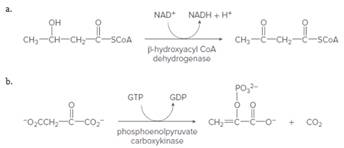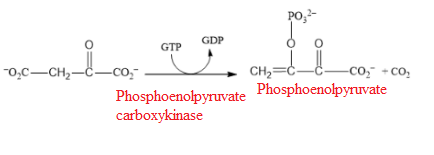
Concept explainers
Analyze each reaction by considering the 
(a)
Interpretation:
The given reaction catalyzed by beta-hydroxyacyl CoA dehydrogenase should be analyzed by taking consideration of the functional groups that can change reactant or coenzyme and name of enzyme.
Concept Introduction:
The catalysts which drives the rate of reaction are known as enzymes. Most of the catalyst are made up of proteins (chain of amino acids) which accelerate the rate of reactions in chemical system.
Answer to Problem 23P
The oxidation of β-hydroxy acyl CoA to form β -keto acyl CoA in the presence of an enzyme β-hydroxy acyl CoA dehydrogenase.
Explanation of Solution
The given reaction is represented as follows:

In the given reaction oxidation of β-hydroxy acyl CoA to form β -keto acyl CoA. In this reaction hydroxyl group changes to ketone group that means oxidation is taking place. The reaction is catalyzed by an enzyme known as β-hydroxy acyl CoA dehydrogenase which reduces NAD+ to NADH + H+. Hence, the reaction is said to be oxidation reaction.
(b)
Interpretation:
The given reaction catalyzed by phosphoenolpyruvate carboxykinase needs to be analyzed by taking consideration of the functional groups that can change reactant or coenzyme and name of enzyme.
Concept Introduction:
The catalysts which drives the rate of reaction are known as enzymes. Most of the catalyst are made up of proteins (chain of amino acids) which accelerate the rate of reactions in chemical system.
Answer to Problem 23P
The introduction of phosphate group is taking place with the help of Phosphoenolpyruvate enzyme.
Explanation of Solution
The reaction is represented as follows:

The reactant in the following above reaction is phosphorylating with GTP to produce phosphoenolpyruvate and GDP. Phosphoenolpyruvate (acts as an enzyme) catalyzes the reaction and removes carbon dioxide. And addition of phosphate group also takes place in the reaction.
Want to see more full solutions like this?
Chapter 24 Solutions
Connect One Semester Access Card for General, Organic, & Biological Chemistry
- 2. Propose an efficient synthesis for each of the following transformations. Pay careful attention to both the regio and stereochemical outcomes. ¡ H H racemicarrow_forwardZeroth Order Reaction In a certain experiment the decomposition of hydrogen iodide on finely divided gold is zeroth order with respect to HI. 2HI(g) Au H2(g) + 12(9) Rate = -d[HI]/dt k = 2.00x104 mol L-1 s-1 If the experiment has an initial HI concentration of 0.460 mol/L, what is the concentration of HI after 28.0 minutes? 1 pts Submit Answer Tries 0/5 How long will it take for all of the HI to decompose? 1 pts Submit Answer Tries 0/5 What is the rate of formation of H2 16.0 minutes after the reaction is initiated? 1 pts Submit Answer Tries 0/5arrow_forwardangelarodriguezmunoz149@gmail.com Hi i need help with this question i am not sure what the right answers are.arrow_forward
- Saved v Question: I've done both of the graphs and generated an equation from excel, I just need help explaining A-B. Below is just the information I used to get the graphs obtain the graph please help. Prepare two graphs, the first with the percent transmission on the vertical axis and concentration on the horizontal axis and the second with absorption on the vertical axis and concentration on the horizontal axis. Solution # Unknown Concentration (mol/L) Transmittance Absorption 9.88x101 635 0.17 1.98x101 47% 0.33 2.95x101 31% 0.51 3.95x10 21% 0.68 4.94x10 14% 24% 0.85 0.62 A.) Give an equation that relates either the % transmission or the absorption to the concentration. Explain how you arrived at your equation. B.) What is the relationship between the percent transmission and the absorption? C.) Determine the concentration of the ironlll) salicylate in the unknown directly from the graph and from the best fit trend-line (least squares analysis) of the graph that yielded a straight…arrow_forwardDon't used Ai solutionarrow_forwardCalculate the differences between energy levels in J, Einstein's coefficients of estimated absorption and spontaneous emission and life time media for typical electronic transmissions (vnm = 1015 s-1) and vibrations (vnm = 1013 s-1) . Assume that the dipolar transition moments for these transactions are in the order of 1 D.Data: 1D = 3.33564x10-30 C m; epsilon0 = 8.85419x10-12 C2m-1J-1arrow_forward
 World of Chemistry, 3rd editionChemistryISBN:9781133109655Author:Steven S. Zumdahl, Susan L. Zumdahl, Donald J. DeCostePublisher:Brooks / Cole / Cengage Learning
World of Chemistry, 3rd editionChemistryISBN:9781133109655Author:Steven S. Zumdahl, Susan L. Zumdahl, Donald J. DeCostePublisher:Brooks / Cole / Cengage Learning World of ChemistryChemistryISBN:9780618562763Author:Steven S. ZumdahlPublisher:Houghton Mifflin College Div
World of ChemistryChemistryISBN:9780618562763Author:Steven S. ZumdahlPublisher:Houghton Mifflin College Div Chemistry for Today: General, Organic, and Bioche...ChemistryISBN:9781305960060Author:Spencer L. Seager, Michael R. Slabaugh, Maren S. HansenPublisher:Cengage Learning
Chemistry for Today: General, Organic, and Bioche...ChemistryISBN:9781305960060Author:Spencer L. Seager, Michael R. Slabaugh, Maren S. HansenPublisher:Cengage Learning General, Organic, and Biological ChemistryChemistryISBN:9781285853918Author:H. Stephen StokerPublisher:Cengage Learning
General, Organic, and Biological ChemistryChemistryISBN:9781285853918Author:H. Stephen StokerPublisher:Cengage Learning Organic And Biological ChemistryChemistryISBN:9781305081079Author:STOKER, H. Stephen (howard Stephen)Publisher:Cengage Learning,
Organic And Biological ChemistryChemistryISBN:9781305081079Author:STOKER, H. Stephen (howard Stephen)Publisher:Cengage Learning, Introductory Chemistry: An Active Learning Approa...ChemistryISBN:9781305079250Author:Mark S. Cracolice, Ed PetersPublisher:Cengage Learning
Introductory Chemistry: An Active Learning Approa...ChemistryISBN:9781305079250Author:Mark S. Cracolice, Ed PetersPublisher:Cengage Learning





